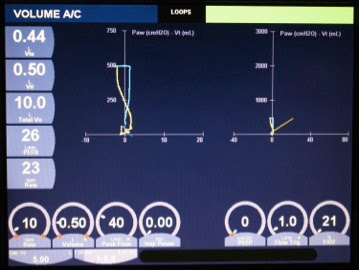その2の続き
下の図のようなPVループの問題を修正する方法
Increase
the Peak Inspiratory Flowrate
Many times an easy option to correct this
type of patient-ventilator dys-synchrony is to increase the peak inspiratory
flowrate so that the set flowrate now meets the patient’s demand. It is
important to understand the ventilator to make sure that increasing the peak
flowrate does not alter the tidal volume.
最高吸気流速を上げる
多くの場合、このタイプの患者−人工呼吸器非同調を修正するのに簡便な方法は最高吸気流速を上げて患者の需要に見合った吸気流速に設定することです。この場合、人工呼吸器の特性を理解し、吸気流速設定を上げることで換気量が変化することがないように確認することが重要です。
Change
to a Rectangular Flow Waveform
When ventilating a patient in
volume-targeted ventilation, it is possible on most ventilators to select a
decelerating or a rectangular flow waveform. If a decelerating flow waveform is
selected, the flowrate gradually decreases throughout inspiration. In some
patients, this reduction in flowrate may decrease below the patient’s actual
inspiratory flowrate, resulting in patient-ventilator dys-synchrony and the Figure on the PV Loop. If the flow waveform is changed to a rectangular flow
waveform, the ventilator will deliver the set peak flowrate throughout
inspiration, possibly reducing the patient-ventilator dys-synchrony.
流速波形を矩形波へ変更する
量規定換気の場合、ほとんどの人工呼吸器では漸減波と矩形波のどちらかを選択することができます。漸減波を選択すると、吸気相全般に渡って吸気流速が低下するため、患者によっては実際の吸気流速を下回るところまで減少し、図のような患者−人工呼吸器の不同調に至ることがあります。矩形波へ変更すると、人工呼吸器は吸気全般に渡って設定された一定の吸気流速を維持するため、患者−人工呼吸器非同調を緩和する可能性があります。
Increase
the set Tidal Volume
Increasing the set tidal volume may correct
the situation. However, it is very important to make sure that the tidal volume
is not too high as it may increase the chance of ventilator-induced lung
injury.
設定1回換気量を増加させる
設定1回換気量を増加させることで解決できることがあります。しかし、1回換気量を高くしすぎることで、人工呼吸器による肺損傷(ventilator-induced lung injury:VILI)の危険性を高めることのないよう確認することが重要です。
Change
to a different Ventilator Mode
Another option is to change the mode of
ventilation. If the patient is changed to a pressure-targeted mode of
ventilation, the patient will now have control over the inspiratory flowrate.
This generally results in an improved patient-ventilator synchrony.
換気モードを変更する
もう一つの方法は、換気モードを変更することです。圧規定換気に変更すれば、患者は吸気流速の規定を受けず、自分でコントロールすることができます。通常は圧規定換気に変更することで患者−人工呼吸器同調性は改善します。
Use
of Medications to Improve Patient-Ventilator Synchrony
Medications can be used to improve
patient-ventilator synchrony. However, it is important that the patient is not
just automatically heavily sedated. Increasing emphasis is being placed on not
sedating the patient as much as was done in the past. Instead, appropriate use
of pain control and control of anxiety are encouraged.
患者−人工呼吸器同調性を高めるために薬剤を使用する
患者−人工呼吸器同調性を高めるために薬剤を用いることも可能です。しかし、安易に患者を深い鎮静下に置かないことが重要です。過去に我々がしてきたような過鎮静をしないことが、ますます強調されてきています。その代り、適切な鎮痛と不安への対処が奨励されます。
The next post will discuss “beaking” in a
PV Loop that may be caused by over-distension or by a patient activating his
expiratory muscles while the ventilator is still delivering a breath.
次回の投稿ではPVループにおける“ビーキング”(くちばし様波形)について述べます。これは過膨張もしくは人工呼吸器がまだ吸気を行っている間に、患者が呼気を開始しようと
日本語訳 岩本志津(米国呼吸療法士)


























